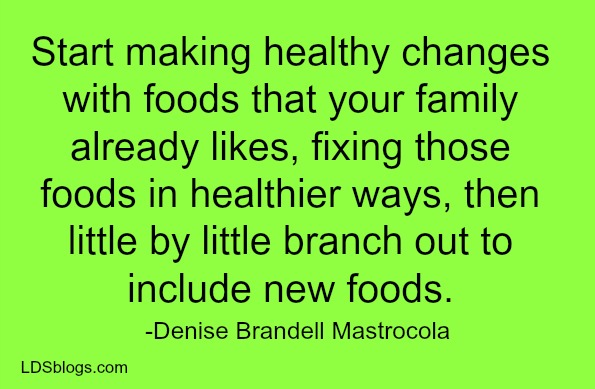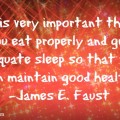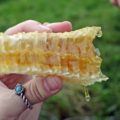** Disclaimer** While the word of wisdom gives us basic guidelines for health, it leaves the interpretation of those guideline up to the individual members. This blog is not intended to replace your medical professional or the divine revelation of the Word of Wisdom, but rather it is practical knowledge that I have accumulated over the years in my own pursuit of a healthier lifestyle which I am passing along in the hopes that it will benefit others.
Every day we are learning more about the role that diet plays in determining our level of health and well-being. It is a fact that dietary practices cause, as well as prevent a variety of diseases. But as we strive to learn more about the value of balanced nutrition it is easy to become confused by the many conflicting opinions.
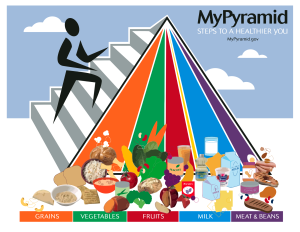
This is the Old version of the Food Pyramid
Some of the questions we might ask are: What constitutes a healthy diet? If food can act as a preventative as well as a medicine, how do we know what foods are best? What proportions of these foods are most beneficial, and for what purposes should we use them to live the healthiest life possible?
What’s a Healthy Diet?
First, let’s talk proportions. Most people are familiar with the food pyramid. This list of foods and the USDA’s recommendation for numbers of servings per day have become a standard taught in school health classes, even influencing the meals served in school cafeterias as well as being promoted by doctors to their patients.
In his book, The Encyclopedia of Healing Foods Dr. Micheal Murray, one of the world’s leading authorities on Natural Medicine, states that the traditional food pyramid is not accurate due to the fact that it does not take into consideration how quickly blood sugar rises after eating certain foods.
It is somewhat deceptive to say, eat so many servings of grains, without specifying what kinds of grains are best to eat. And the term oils is very generic leaving the consumer to figure out for themselves which oils are good and which are bad.
The food pyramid encourages people to eat more grains such as bread, cereals, rice and pasta but these foods can stress our blood sugar levels, especially when they are derived from refined grains. In addition, the oils portion of the food pyramid does not inform consumers that omega 6 oils should be used sparingly while omega 3 oils should be used more widely.
In his book, Dr. Murray suggests using what he calls
The Optimal Health Food Pyramid.
In this pyramid vegetables and oils are at the bottom, and the picture clearly details a healthy ratio of omega 3 to omega 6 oils. Whole grains and legumes are next with the caveat that the grains be low glycemic whole grains. Next are the fruits and high-quality proteins. Dairy is last on the pyramid, supplementation being an option for those who may be dairy intolerant. To the side of the pyramid, it also gives the caution to avoid certain foods that are most likely going to cause our bodies to react in unhealthy ways.
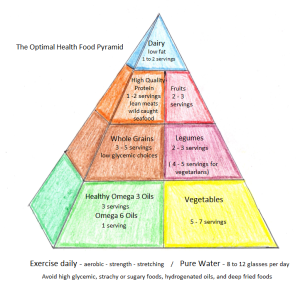
The New and Improved Food Guide Pyramid
Now the question that is on most people’s minds. How do we implement these changes into our diets? We have been used to eating a certain way for a long time, and our habits and those of our families are probably pretty well entrenched.
Yes, it can be a challenge. I’ve known kids who wouldn’t eat if it wasn’t boxed macaroni and cheese, hot dogs, or a kid’s meal from the local fast food place, but with a bit of persistence, parents can help their families to make better choices.
If you have a picky eater don’t overwhelm them. Introduce one new food at a time, and try to make the food colorful and interesting. If for instance your child likes hard boiled eggs, but will only eat white bread. Try toasting a slice of whole grain bread and using a large cookie cutter, or a knife, turn it into a fun shape. Chop the egg up mixing it with a little mayonnaise and mustard, similar to a deviled egg. Spread it on top of the toast shape, and you have a fun open-faced breakfast sandwich. Add to this meal freshly cut apple slices with a natural, peanut butter to dip them in and you have a well-balanced, fun breakfast.
I understand the appeal of cold cereals, they are quick and easy, and taste good, but try to avoid eating them on a daily basis. Processed cereals are what are called dead foods. Even the best of them are highly processed and have very little real nutritional value while they are packed with refined carbs, sugar, and various preservatives.
Start making changes with foods that your family already likes, fixing those foods in healthier ways, then little by little branch out to include new foods.
For some people, change is hard so try to make the transition as painless as you can and be patient. Remember old habits are not changed overnight and you’ll have better success if you can get your family to participate willingly.
For children over the age of 5, it might be worth it to make it a challenge, perhaps even offering rewards to your children for being willing to try something new. Get some poster board and make a chart. Each time they try something new they get a star or maybe get to pick a fun sticker to put under their name. After receiving a predetermined number of stars/stickers they get their reward. Maybe a trip to the park, or the promise of a movie night complete with a favorite family treat.

To read more of Denise’s articles, click here.
Another idea could be to have a family home evening where each family member has to look up a new food and present it at the activity telling where it is grown, and how it is used. Give each family member a chance to suggest how they would like to try it at a family meal sometime. Make a game of it, with the one rule being that all suggestions for the new foods must be positive and healthy.
Getting healthier is a family affair, but it doesn’t have to be a grueling tug of war. Our bodies are the home of our souls and should be cherished and well cared for.
Make healthy eating a lifelong habit, and enjoy life to the fullest!
About Denise Mastrocola
Denise is a Michigander turned Pennsylvanian, who has been writing stories since Elementary School. Denise won an award at the annual Lansing Youth Talent Show, when she was in 10th grade, for a short story entitled Procrastination is Fatal, but didn’t decide on writing as a career until she was 28 years old. While homeschooling her older children she spent 4 years working through a course from The Institute of Children’s Literature.
Through the years Denise’s children have had a variety of health issues, many of which have been linked to various sensitives; having spent more than 20 years researching and trying different things Denise has a boots on the ground view on healthier living.
Denise currently writes for 2 blogs and has several books in different stages of completion. She is planning to break ground in e publishing, and hopes to have her first Historical Fantasy book which is set during the renaissance, “Lisa, My Lisa?” ready by the first of the year.
Twitter •

